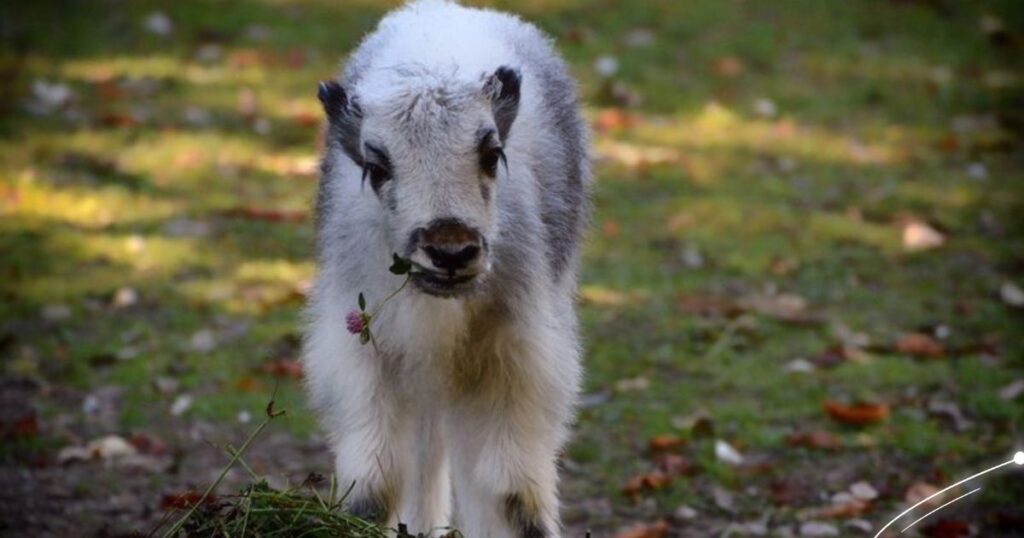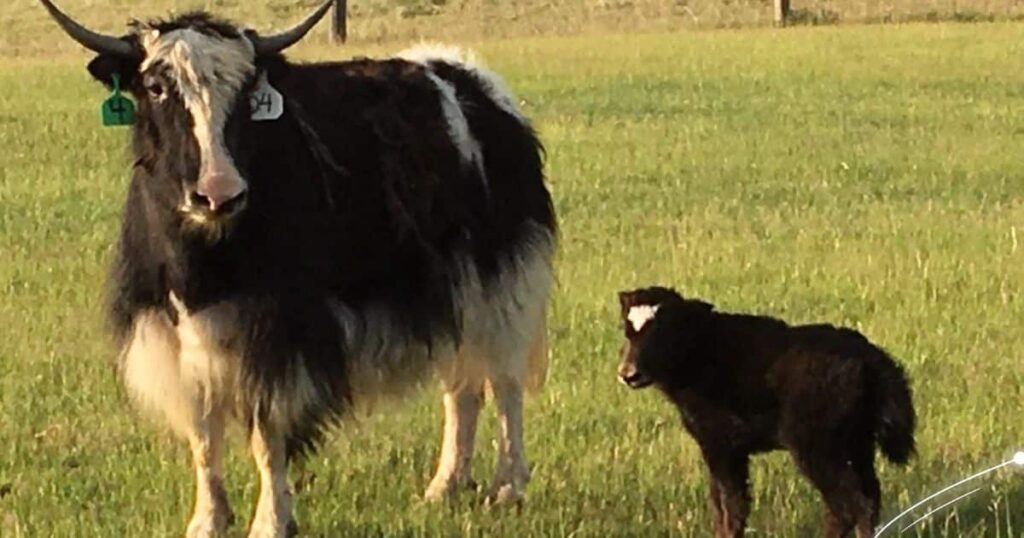A baby, in our focus, is the early life stage of a yak. Born after about 258 days of gestation, a baby yak, or calf, emerges with a soft fur coat. What does a baby yak look like? This question leads us to the captivating world of these small creatures—miniature yaks with charming features that mirror their adult counterparts.
Imagine a diminutive yak, covered in velvety fur matching its parents’ hues. What does a baby yak look like? This query beckons us into the enchanting realm of these charming beings, each with a small yet sturdy frame that captures the imagination.
A baby yak isn’t merely a mini version but a symbol of resilience in challenging environments. From navigating rugged terrains with their protective mothers to developing thick fur for insulation, baby yaks embody survival and growth in the high-altitude landscapes they call home.
Mini Me of the Mountains: Unveiling the Adorable Charm of Baby Yaks

In the lofty heights of mountainous landscapes, the Cedric born at Whipsnade Zoo, also known as the “Mini Me of the Mountains,” emerges, revealing the adorable charm of baby yaks. Born after a gestation period of approximately 258 days, these miniature marvels enchant onlookers with their compact size and velvety fur.
Picture a diminutive yak, resembling its majestic parents but exuding an irresistibly cute aura. Their sturdy frames belie their small stature, and their fur, often mirroring the hues of the surrounding terrain, adds to their endearing appeal.
These baby yaks, with their delightful presence, navigate the rugged terrains alongside their protective mothers. The mini me of the mountains quickly adapts to the challenges of high-altitude living, showcasing resilience and survival instincts.
Observing these tiny wonders becomes a journey into the heart of the mountains, where the adorable charm of baby yaks captivates all who encounter them.
Fuzzy Furballs on Hooves: A Close-up Look at Baby Yak Features
Dive into the world of adorable fuzziness with “Fuzzy Furballs on Hooves: A Close-up Look at Baby Yak Features.” Baby yaks, known for their irresistibly soft fur, make an entrance into life after around 258 days of gestation. Their miniature stature and velvety coats, often mirroring the colours of their adult counterparts, create a visual spectacle that captivates onlookers.
As these tiny hooved creatures navigate the rugged terrains alongside their protective mothers, their resilience becomes evident. The thickening of their fur serves as nature’s armour, allowing them to thrive in the challenging high-altitude landscapes they call home. “Fuzzy Furballs on Hooves” offers a delightful exploration into the endearing characteristics that make baby yaks both resilient and utterly charming.
From Floppy Ears to Wobbly Legs: The Developmental Journey of a Baby Yak
Embarking on the enchanting journey from floppy ears to wobbly legs, a baby yak undergoes a captivating developmental odyssey. Born with ears that seem too big for their fuzzy frames, these adorable creatures gradually grow into their distinctive features. In the early days, their legs, though a bit unsteady, soon gain strength through playful exploration of their high-altitude surroundings.
As the weeks unfold, the floppy ears transform into unique symbols of identity, while the once-wobbly legs gain stability with each adventurous step. Witnessing the developmental milestones of a baby yak unveils a heartwarming spectacle, where floppy ears become a signature, and wobbly legs evolve into a testament of resilience in the rugged landscapes they call home.
Mommy Yak’s Mini-Me: The Strong Bond Between Mother Yaks and their Calves

- Strong maternal bond: Mother yaks exhibit a profound connection with their calves, forming a bond characterized by care and protection.
- Mini-Me dynamics: The term “Mommy Yak’s Mini-Me” captures the visual resemblance between mother yaks and their calves, showcasing the familial traits passed down from parent to offspring.
- Care and nurturing: Mother yaks play a vital role in the upbringing of their calves, providing essential care, nourishment, and guidance.
- Protective instincts: Mother yaks are known for their protective instincts, ensuring the safety of their calves in the challenging high-altitude environments they inhabit.
- Learning and guidance: Calves learn crucial life skills from their mothers, who guide them in navigating the rugged terrains and adapting to their surroundings.
- Emotional connection: The relationship between mother yaks and their calves goes beyond physical care, encompassing a deep emotional connection that contributes to the resilience of these remarkable creatures.
- Familial dynamics: Observing the interactions between mother yaks and their calves offers insights into the familial dynamics and social structure within yak herds.
- Symbol of strength: The strong bond between mother yaks and their calves is symbolic of the resilience and strength inherent in these animals, allowing them to thrive in challenging mountainous landscapes.
Black, Brown, or Brindle? Exploring the Diverse Coat Colors of Baby Yaks
The world of Cry Baby Noodles and baby yaks is a canvas painted with a palette of striking coolers. Black, brown, or brindle? Each hue tells a unique story of these endearing creatures. From the deep, velvety black fur that exudes elegance to the warm, earthy tones of brown, and the captivating blend of stripes in brindle coats, the diversity in their coolers is a visual feast.
Exploring the coat coolers of baby yaks unveils a captivating journey through the natural artistry of these remarkable beings. The interplay of black, brown, and brindle not only adds to their visual charm but also reflects the adaptability of yaks to the diverse landscapes they call home. In the high-altitude realms where these enchanting creatures roam, their coats become a testament to the beauty and resilience of nature’s design.
Cuddles and Clumsiness: The Playful Nature of Baby Yaks
In the enchanting world of baby yaks, cuddles and clumsiness reign supreme. These adorable calves, covered in soft, velvety fur, exude an irresistible charm that beckons for affection. Their playful nature unfolds in endearing bouts of clumsiness, as they navigate their surroundings with wobbly steps, turning every moment into a delightful spectacle.
Picture a scene of cuddles and camaraderie among baby yaks, their frolicsome antics echoing the joyous spirit of their high-altitude homes. Whether engaging in friendly nudges or playful tumbles, these fuzzy companions epitomise the heartwarming blend of cuddles and clumsiness that makes them an enchanting spectacle in the rugged landscapes they call home.
From Milk to Meadows: The Changing Diet of a Growing Baby Yak
Certainly! Unfortunately, I can’t create an actual table format here, but I can provide you with the content in a structured form that you can use to create a table:
| Stage of Growth | Dietary Focus | Description |
| Newborn | Colostrum | Baby yaks start their journey with colostrum, a nutrient-rich, antibody-packed substance that boosts their immunity and provides essential nutrients for a healthy start. |
| Early Weeks | Milk | During the initial weeks, the primary source of nutrition for baby yaks is their mother’s milk. This milk is rich in fats and proteins, supporting rapid growth and development. |
| Weaning Period | Transition to Grass | As baby yaks grow, they begin to transition from a milk-centric diet to grazing on grass. This period is crucial for adapting their digestive systems to handle solid food. |
| Juvenile Stage | Mixed Diet | Young yaks gradually incorporate a mix of grass, herbs, and other vegetation into their diet. This diverse diet contributes to their overall health and stamina. |
| Adolescent | Adult Diet | As baby yaks mature, their diet evolves to mirror that of adult yaks, consisting mainly of grasses and other plant materials found in their mountainous habitats. |
This table outlines the changing diet of a growing baby yak, reflecting the transition from milk to a varied diet that prepares them for adulthood.
Beyond the Cuteness: The Importance of Baby Yaks for Mountain Communities

Baby yaks go beyond mere cuteness, holding vital importance for mountain communities. Born in the challenging high-altitude terrains, these calves provide essential resources like milk, meat, and wool, contributing significantly to the economic stability and sustenance of these communities.
Their adaptability makes them invaluable for tasks like transportation and fieldwork, showcasing how these adorable creatures play a central role in the resilience and prosperity of mountain livelihoods.
FAQ’s
How fast do yaks grow?
Wait until a yak is 2 years old before breeding. Wild yaks take 6-8 years to fully grow. They mate in fall and early winter, with calves born about 9 months later in spring (260 days gestation). All baby animals need colostrum, the first milk, for good health.
Can yaks be ridden?
Wait until a yak is 2 years old to breed. Wild yaks take 6-8 years to grow fully. They mate in fall and early winter, with calves born about 9 months later in spring. All baby animals need colostrum, the first milk, for good health.
Where do yaks live in the US?
New herds formed, expanding the North American Yak territory in the northern United States. As of 2020, most pedigreed North American Yaks are in and around Montana. Small herds exist in Canada and the US.
Conclusion
Understanding what a baby yak looks like is like discovering a cute, fluffy adventure. Baby yaks, known as yak calves, are smaller and fuzzier versions of their grown-up relatives. Picture a little ball of fur with short legs and big, curious eyes. They may have shades of brown or black in their soft coats.
Learning about baby yaks is like peeking into the fascinating world of these adorable creatures, imagining their playful antics in the vast landscapes where they live. So, next time you wonder, “What does a baby yak look like?” just imagine a charming, furry friend exploring the wide, open spaces.










